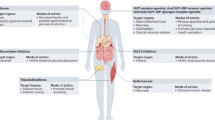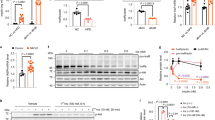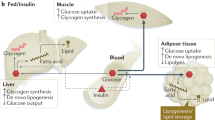Abstract
THE first evidence for an abnormality in insulin receptor capacity in pathological states was provided by Kahn et al.1, who found that liver plasma membranes from the obese hyperglycaemic mouse bound only a fraction of insulin compared with membranes from lean littermates. A similar observation was made with lymphocytes from obese insulin-resistant diabetic patients2. In lymphocyte cultures the insulin concentration in the medium seemed to determine the binding capacity of the cells3. These results suggested an inverse relationship between the number of receptors and the surrounding concentration of insulin, regardless of the tissue sensitivity to the hormone. We have now found greater than normal binding capacity in the diabetic Chinese hamster, which has genetic insulin deficiency, in many ways resembling juvenile diabetes4.
This is a preview of subscription content, access via your institution
Access options
Subscribe to this journal
Receive 51 print issues and online access
$199.00 per year
only $3.90 per issue
Buy this article
- Purchase on SpringerLink
- Instant access to full article PDF
Prices may be subject to local taxes which are calculated during checkout
Similar content being viewed by others
References
Kahn, C. R., Neville, D. M., and Roth, J., J. biol. Chem., 248, 244–250 (1973).
Archer, J. A., Gorden, P., Gavin, J. R., Lesniak, M. A., and Roth, J., J. clin. Endocr. Metab., 36, 627–633 (1973).
Gavin, J., Roth, J., Neville, D. M., De Meyts, P., and Buell, D. N., Proc. natn. Acad. Sci. U.S.A., 71, 84–88 (1974).
Gerritsen, G. C., and Dulin, W. E., Diabetologia, 3, 74–84 (1967).
Neville, D. M., Biochim. biophys. Acta, 154, 540–552 (1968).
Solyom, A., and Trams, E. G., Enzyme, 13, 329–372 (1972).
Maeno, H., and Greengard, P., J. biol. Chem., 247, 3269–3277 (1972).
Kahn, C. R., Freychet, P., Roth, J., and Neville, D. M., J. biol. Chem., 249, 2249–2257 (1974).
De Meyts, P., Roth, J., Neville, D. M., Gavin, J. R., and Lesniak, M. A., Biochim. biophys. Res. Commun., 55, 154–161 (1973).
House, P. D. R., FEBS Lett., 16, 339–342 (1971).
Taylor, S. I., Biochemistry, 14, 2357–2361 (1975).
Kern, P., Picard, J., Caron, M., and Veissière, D., Biochim. biophys. Acta, 389, 281–289 (1975).
Author information
Authors and Affiliations
Rights and permissions
About this article
Cite this article
HEPP, K., LANGLEY, J., VON FUNCKE, H. et al. Increased insulin binding capacity of liver membranes from diabetic Chinese hamsters. Nature 258, 154 (1975). https://doi.org/10.1038/258154a0
Received:
Accepted:
Issue date:
DOI: https://doi.org/10.1038/258154a0
This article is cited by
-
Insulin receptors on circulating blood cells from patients with pancreatogenic diabetes: a comparison with type I diabetes and normal subjects
Journal of Endocrinological Investigation (1987)
-
Enhanced hepatic insulin sensitivity, but peripheral insulin resistance in patients with Type 1 (insulin-dependent) diabetes
Diabetologia (1987)
-
The effect of streptozotocin-induced diabetes on the early steps of glucagon action in isolated rat liver cells
Diabetologia (1980)
-
Insulin binding and insulin action in rat fat cells after adrenalectomy
Diabetologia (1980)
-
Hormonal regulation of peptide receptors and target cell responses
Nature (1979)



